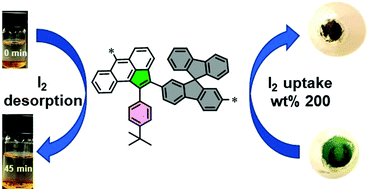Synthesis of conjugated polymers via cyclopentannulation reaction: promising materials for iodine adsorption†
Abstract
A new class of conjugated polymers is prepared by means of a versatile palladium-catalyzed cyclopentannulation reaction using a series of specially designed diethynyl aryl synthons with the commercially available 9,10-dibromoanthracene DBA monomer. The target polymers, CPP1–3, display high solubility and excellent chemical stability, which allow their structural and photophysical characterization by various instrumental analysis techniques such as gel permeation chromatography (GPC), and 1H- and 13C-nuclear magnetic resonance (NMR), Fourier transform infrared (FTIR), UV-vis absorption, and emission spectroscopy. GPC chromatograms of CPP1–3 display a high relative weight-average (Mw) molecular weight in the range of 15.8 to 34.3 kDa with a polydispersity index (Đ = Mw/Mn) of ∼2.5. Investigation of the iodine adsorption properties of CPP1–3 reveals their high uptake, namely ∼200 wt% for CPP2, whose sorption property was sustained even after its reuse several times.



 Please wait while we load your content...
Please wait while we load your content...